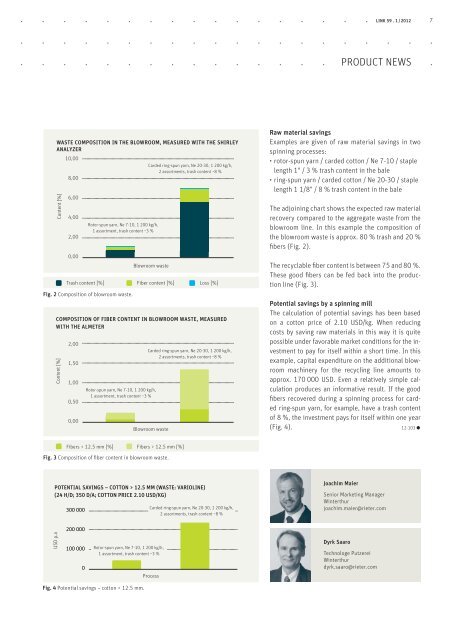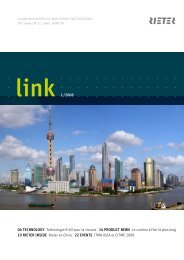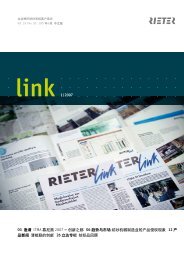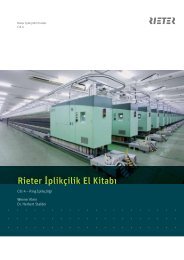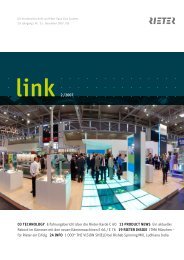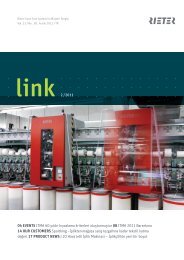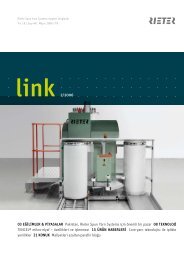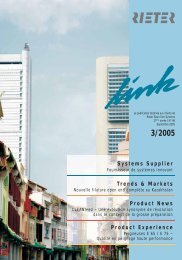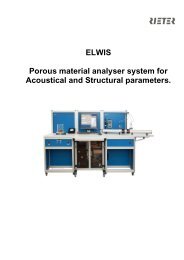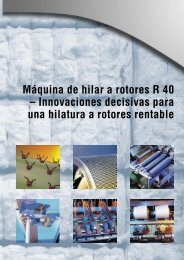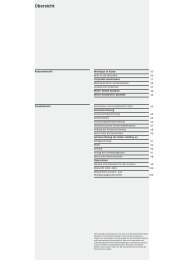link no. 59 customer magazine spun yarn systems - Rieter
link no. 59 customer magazine spun yarn systems - Rieter
link no. 59 customer magazine spun yarn systems - Rieter
Create successful ePaper yourself
Turn your PDF publications into a flip-book with our unique Google optimized e-Paper software.
WASTE COMPOSITION IN THE BLOWROOM, MEASURED WITH THE SHIRLEY<br />
ANALYZER<br />
Content [%]<br />
Trash content [%]<br />
300 000<br />
200 000<br />
100 000<br />
0<br />
Rotor-<strong>spun</strong> <strong>yarn</strong>, Ne 7-10, 1 200 kg/h,<br />
1 assortment, trash content ~3 %<br />
Fig. 2 Composition of blowroom waste.<br />
Carded ring-<strong>spun</strong> <strong>yarn</strong>, Ne 20-30, 1 200 kg/h,<br />
2 assortments, trash content ~8 %<br />
Blowroom waste<br />
Fiber content [%] Loss [%]<br />
COMPOSITION OF FIBER CONTENT IN BLOWROOM WASTE, MEASURED<br />
WITH THE ALMETER<br />
Content [%]<br />
Rotor-<strong>spun</strong> <strong>yarn</strong>, Ne 7-10, 1 200 kg/h,<br />
1 assortment, trash content ~3 %<br />
Fibers < 12.5 mm [%]<br />
Carded ring-<strong>spun</strong> <strong>yarn</strong>, Ne 20-30, 1 200 kg/h,<br />
2 assortments, trash content ~8 %<br />
Blowroom waste<br />
Fibers > 12.5 mm [%]<br />
Fig. 3 Composition of fiber content in blowroom waste.<br />
POTENTIAL SAVINGS – COTTON > 12.5 MM (WASTE: VARIOLINE)<br />
(24 H/D; 350 D/A; COTTON PRICE 2.10 USD/KG)<br />
USD p.a<br />
10,00<br />
8,00<br />
6,00<br />
4,00<br />
2,00<br />
0,00<br />
2,00<br />
1,50<br />
1,00<br />
0,50<br />
0,00<br />
Rotor-<strong>spun</strong> <strong>yarn</strong>, Ne 7-10, 1 200 kg/h,<br />
1 assortment, trash content ~3 %<br />
Fig. 4 Potential savings – cotton > 12.5 mm.<br />
Carded ring-<strong>spun</strong> <strong>yarn</strong>, Ne 20-30, 1 200 kg/h,<br />
2 assortments, trash content ~8 %<br />
Process<br />
Joachim Maier<br />
Dyrk Saaro<br />
LINK <strong>59</strong> . 1 /2012<br />
PRODUCT NEWS<br />
Raw material savings<br />
Examples are given of raw material savings in two<br />
spinning processes:<br />
• rotor-<strong>spun</strong> <strong>yarn</strong> / carded cotton / Ne 7-10 / staple<br />
length 1" / 3 % trash content in the bale<br />
• ring-<strong>spun</strong> <strong>yarn</strong> / carded cotton / Ne 20-30 / staple<br />
length 1 1/8" / 8 % trash content in the bale<br />
The adjoining chart shows the expected raw material<br />
recovery compared to the aggregate waste from the<br />
blowroom line. In this example the composition of<br />
the blowroom waste is approx. 80 % trash and 20 %<br />
fibers (Fig. 2).<br />
The recyclable fiber content is between 75 and 80 %.<br />
These good fibers can be fed back into the production<br />
line (Fig. 3).<br />
Potential savings by a spinning mill<br />
The calculation of potential savings has been based<br />
on a cotton price of 2.10 USD/kg. When reducing<br />
costs by saving raw materials in this way it is quite<br />
possible under favorable market conditions for the investment<br />
to pay for itself within a short time. In this<br />
example, capital expenditure on the additional blowroom<br />
machinery for the recycling line amounts to<br />
approx. 170 000 USD. Even a relatively simple calculation<br />
produces an informative result. If the good<br />
fibers recovered during a spinning process for carded<br />
ring-<strong>spun</strong> <strong>yarn</strong>, for example, have a trash content<br />
of 8 %, the investment pays for itself within one year<br />
(Fig. 4). 12-103 •<br />
Senior Marketing Manager<br />
Winterthur<br />
joachim.maier@rieter.com<br />
Tech<strong>no</strong>loge Putzerei<br />
Winterthur<br />
dyrk.saaro@rieter.com<br />
7


